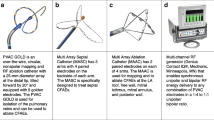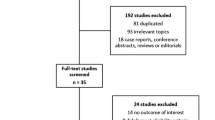Abstract
Background
Pulmonary vein isolation is the cornerstone of atrial fibrillation (AF) ablation. However, the recurrence rate of AF after pulmonary vein isolation (PVI) remains high. The efficacy and safety of low voltage area (LVA) ablation in the treatment of AF are uncertain.
Methods
The studies comparing the efficacy and safety of LVA ablation and LVA non-ablation for AF were systematically reviewed and meta-analyzed. Outcomes of interest included recurrent event, procedure time, and fluoroscopy time. Continuous variables were evaluated with mean deviation (MD) and standard mean difference (SMD). Odds ratio (OR) values and its 95% confidence intervals (CI) were used in meta-analysis of binary variables.
Results
Fourteen studies were eligible for inclusion. The AF recurrence was similar between the two groups, with no statistical difference (25.7% (67/346) vs. 28% (63/225), P = 0.49). LVA ablation did not increase the incidence of AT (8.7% (20/231) vs. 14.5% (28/193), P = 0.66). Fluoroscopy time was longer in the LVA ablation group (31.4 ± 8.4 min vs. 26.3 ± 7.8 min, P < 0.05). Complication rates were similar between the two groups (26.6% (17/64) vs. 21.7% (13/60), P = 0.53). Patients with LVA had higher AT/AF recurrence (32.9% (213/647) vs. 24.2% (229/948), P < 0.05).
Conclusions
Patients with left atrial LVA have a poor prognosis after catheter ablation. LVA ablation did not reduce the recurrence of AF nor did it increase the recurrence of atrial tachycardia.




Similar content being viewed by others
References
Mark DB, Anstrom KJ, Sheng S, Piccini JP, Baloch KN, Monahan KH, Daniels MR, Bahnson TD, Poole JE, Rosenberg Y, Lee KL, Packer DL. Effect of catheter ablation vs medical therapy on quality of life among patients with atrial fibrillation: the CABANA Randomized Clinical Trial. JAMA. 2019;321:1275–85.
Kircher S, Arya A, Altmann D, Rolf S, Bollmann A, Sommer P, Dagres N, Richter S, Breithardt O-A, Dinov B, Husser D, Eitel C, Gaspar T, Piorkowski C, Hindricks G. Individually tailored vs. standardized substrate modification during radiofrequency catheter ablation for atrial fibrillation: a randomized study. Europace. 2017;20:1766–75.
Jadidi AS, Lehrmann H, Keyl C, Sorrel J, Markstein V, Minners J, Park C-I, Denis A, Jaïs P, Hocini M, Potocnik C, Allgeier J, Hochholzer W, Herrera-Siklody C, Kim S, Omri YE, Neumann F-J, Weber R, Haïssaguerre M, Arentz T. Ablation of persistent atrial fibrillation targeting low-voltage areas with selective activation characteristics. Circ Arrhythm Electrophysiol. 2016;9:e002962.
Wang X-h, Li Z, Mao J-l, He B. A novel individualized substrate modification approach for the treatment of long-standing persistent atrial fibrillation: preliminary results. Int J Cardiol. 2014;175:162–8.
Masuda M, Asai M, Iida O, Okamoto S, Ishihara T, Nanto K. Additional low-voltage-area ablation in patients with paroxysmal atrial fibrillation: results of the randomized controlled VOLCANO trial. J Am Heart Assoc. 2020;9:e015927.
Nery PB, Alqarawi W, Nair GM, Sadek MM, Redpath CJ, Golian M, Dawood W, Chen L, Hansom SP, Klein A, Wells EA, Birnie DH. Catheter ablation of low-voltage areas for persistent atrial fibrillation: procedural outcomes using high-density voltage mapping. Can J Cardiol. 2020;36:1956–64.
Kumagai K, Toyama H, Zhang B. Effects of additional ablation of low-voltage areas after Box isolation for persistent atrial fibrillation. J Arrhythmia. 2019;35:197–204.
Yamaguchi T, Tsuchiya T, Nakahara S, Fukui A, Nagamoto Y, Murotani K, Eshima K, Takahashi N. Efficacy of left atrial voltage-based catheter ablation of persistent atrial fibrillation. J Cardiovasc Electrophysiol. 2016;27:1055–63.
Masuda M, Fujita M, Iida O, Okamoto S, Ishihara T, Nanto K, Kanda T, Sunaga A, Tsujimura T, Matsuda Y, Ohashi T, Uematsu M. An E/e’ ratio on echocardiography predicts the existence of left atrial low-voltage areas and poor outcomes after catheter ablation for atrial fibrillation. Europace. 2017;20:e60–8.
Yamaguchi T, Tsuchiya T, Nagamoto Y, Miyamoto K, Murotani K, Okishige K, Takahashi N. Long-term results of pulmonary vein antrum isolation in patients with atrial fibrillation: an analysis in regards to substrates and pulmonary vein reconnections. Europace. 2014;16:511–20.
Wang X-H, Li Z, Mao J-L, Zang M-H, Pu J. Low voltage areas in paroxysmal atrial fibrillation: the prevalence, risk factors and impact on the effectiveness of catheter ablation. Int J Cardiol. 2018;269:139–44.
Yamaji H, Higashiya S, Murakami T, Hina K, Kawamura H, Murakami M, Kamikawa S, Hirohata S, Kusachi S. Efficacy of an adjunctive electrophysiological test-guided left atrial posterior wall isolation in persistent atrial fibrillation without a left atrial low-voltage area. Circ Arrhythm Electrophysiol. 2020;13:e008191.
Rolf S, Kircher S, Arya A, Eitel C, Sommer P, Richter S, Gaspar T, Bollmann A, Altmann D, Piedra C, Hindricks G, Piorkowski C. Tailored atrial substrate modification based on low-voltage areas in catheter ablation of atrial fibrillation. Circ Arrhythm Electrophysiol. 2014;7:825–33.
Yagishita A, Gimbel JR, Oliveira SD, Manyam H, Sparano D, Cakulev I, Mackall J, Arruda M. Long-term outcome of left atrial voltage-guided substrate ablation during atrial fibrillation: a novel adjunctive ablation strategy. J Cardiovasc Electrophysiol. 2017;28:147–55.
Kornej J, Schumacher K, Dinov B, Kosich F, Sommer P, Arya A, Husser D, Bollmann A, Lip GYH, Hindricks G. Prediction of electro-anatomical substrate and arrhythmia recurrences using APPLE, DR-FLASH and MB-LATER scores in patients with atrial fibrillation undergoing catheter ablation. Sci Rep. 2018;8:12686.
Ahmed-Jushuf F, Murgatroyd F, Dhillon P, Scott PA. The impact of the presence of left atrial low voltage areas on outcomes from pulmonary vein isolation. J Arrhythm. 2019;35:205–14.
Hindricks G, Potpar T, Dagres N, Arbelo E, Bax JJ, Blomström-Lundqvist C, Boriani G, Castella M, Dan G-A, Dilaveris PE, Fauchier L, Filippatos G, Kalman JM, Meir ML. ESC Guidelines for the diagnosis and management of atrial fibrillation developed in collaboration with the European Association for Cardio-Thoracic Surgery (EACTS). Eur Heart J. 2020;2021(42):373–498.
Li D, Fareh S, Leung TK, Nattel S. Promotion of atrial fibrillation by heart failure in dogs: atrial remodeling of a different sort. Circulation. 1999;100:87–95.
Burstein B, Nattel S. Atrial fibrosis: mechanisms and clinical relevance in atrial fibrillation. J Am Coll Cardiol. 2008;51:802–9.
Sakata K, Okuyama Y, Ozawa T, Haraguchi R, Nakazawa K, Tsuchiya T, Horie M, Ashihara T. Not all rotors, effective ablation targets for nonparoxysmal atrial fibrillation, are included in areas suggested by conventional indirect indicators of atrial fibrillation drivers: ExTRa mapping project. J Arrhythm. 2018;34:176–84.
Kamino K. Optical approaches to ontogeny of electrical activity and related functional organization during early heart development. Physiol Rev. 1991;71:53–91.
Cutler MJ, Johnson J, Abozguia K, Rowan S, Lewis W, Costantini O, Natale A, Ziv O. Impact of voltage mapping to guide whether to perform ablation of the posterior wall in patients with persistent atrial fibrillation. J Cardiovasc Electrophysiol. 2016;27(1):13–21.
Kosiuk J, Dinov B, Kornej J, Acou W-J, Schönbauer R, Fiedler L, Buchta P, Myrda K, Gąsior M, Poloński L, Kircher S, Arya A, Sommer P, Bollmann A, Hindricks G, Rolf S. Prospective, multicenter validation of a clinical risk score for left atrial arrhythmogenic substrate based on voltage analysis: DR-FLASH score. Heart Rhythm. 2015;12:2207–12.
Yamaguchi T, Tsuchiya T, Fukui A, Kawano Y, Otsubo T, Takahashi Y, Hirota K, Murotani K, Eshima K, Takahashi N. Impact of the extent of low-voltage zone on outcomes after voltage-based catheter ablation for persistent atrial fibrillation. J Cardiol. 2018;72:427–33.
Hohendanner F, Romero I, Blaschke F, Heinzel FR, Pieske B, Boldt L-H, Parwani AS. Extent and magnitude of low-voltage areas assessed by ultra-high-density electroanatomical mapping correlate with left atrial function. Int J Cardiol. 2018;272:108–12.
Acknowledgements
We acknowledge the support received from the project prevention of cardiogenic stroke and Strategies for training primary hospitals in Liaoning Province (Fund no.2019jh6/10400005).
Funding
This study was funded by the project prevention of cardiogenic stroke and Strategies for training primary hospitals in Liaoning Province (Fund no.2019jh6/10400005).
Author information
Authors and Affiliations
Corresponding author
Ethics declarations
Ethics approval
This study was approved by the ethics committee within the hospital and performed in accordance with the ethical standards as laid down in the 1964 Declaration of Helsinki.
Conflict of interest
The authors declare no competing interests.
Additional information
Publisher's note
Springer Nature remains neutral with regard to jurisdictional claims in published maps and institutional affiliations.
Supplementary Information
Below is the link to the electronic supplementary material.
Rights and permissions
Springer Nature or its licensor holds exclusive rights to this article under a publishing agreement with the author(s) or other rightsholder(s); author self-archiving of the accepted manuscript version of this article is solely governed by the terms of such publishing agreement and applicable law.
About this article
Cite this article
Jia, H., Wang, W. & Yu, B. Efficacy and safety of low voltage area ablation for atrial fibrillation: a systematic review and meta-analysis. J Interv Card Electrophysiol 66, 1519–1527 (2023). https://doi.org/10.1007/s10840-022-01258-1
Received:
Accepted:
Published:
Issue Date:
DOI: https://doi.org/10.1007/s10840-022-01258-1




